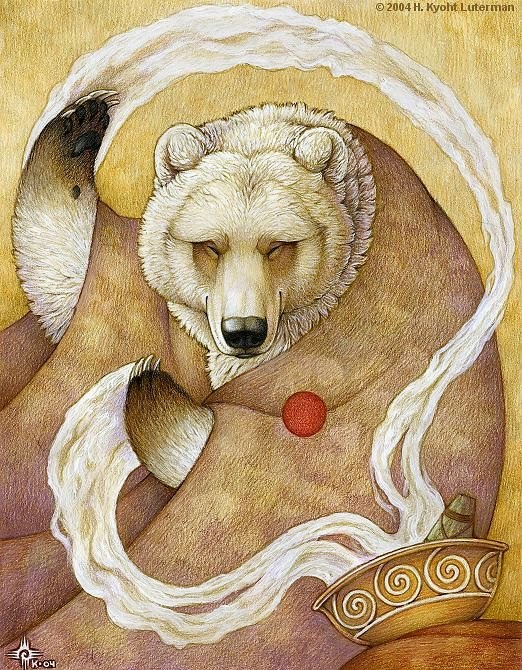Salish
Somewhere near the mouth of the Fraser River lived a girl who had refused all suitors.
After a while, a man came to visit her and lay with her at night.
The girl said to him, "You must stay until daylight, and show yourself to my parents."
He answered, "No, I am too poor. Your people would not like me."
As he continued to come every night, the girl told her parents, and they were very angry. Then Fish-Man caused the sea to recede for many miles from the village. He let all the freshwater streams dry up, and no rainfall. The animals became thirsty and left the country. The people could get no fish, no game, and no water to drink.
The girl told the people, "My lover has done this because you were wroth with him and refused him."
Then the people made a long walk of planks over the mud to the edge of the sea. At the end of this they built a large platform of planks, which they covered with mats. They heaped many woolen blankets on it. Then they dressed the girl in a fine robe, combed and oiled her hair, painted her face, and put down on her head. Then they placed her on the top of the blankets and left her there. At once the sky became overcast, rain fell, the springs burst out, the streams ran, and the sea came in. The people watched until the sea rose and floated the platform with the blankets. They saw a man climb up beside the girl
They stood up, and the girl called, "Now all is well. I shall visit you soon."
Night came on, and they saw them no more. In two days she came back and told the people, "I live below the sea, in the fish country. The houses there are just the same as here, and the people live in the same way."
She returned again with her husband bringing presents of fish. She said, "Henceforth people here shall always be able to catch plenty of fish."
Once more she came to show them her newly born child. After that she returned to the sea and was never seen again.
Source: Franz Boas, Folk-Tales of Salishan and Sahaptin Tribes = Memoirs of the American Folk-Lore Society, vol. 11 (Lancaster and New York: American Folk-Lore Society, 1917), p. 131.
This tale was collected by James A. Teit.
A note by Teit concerning his source: "This myth ... I collected at Hope [on the Fraser River], where interior influence is rather strong. Similar versions are said to be current among the Spuzzum Indians. The narrator was an old man who could speak some Thompson.
The Fraser River flows through British Columbia, Canada, into the Strait of Georgia at the site of present-day Vancouver.
This tale was collected by James A. Teit.
A note by Teit concerning his source: "This myth ... I collected at Hope [on the Fraser River], where interior influence is rather strong. Similar versions are said to be current among the Spuzzum Indians. The narrator was an old man who could speak some Thompson.
The Fraser River flows through British Columbia, Canada, into the Strait of Georgia at the site of present-day Vancouver.
Artist: Carl Ray, a self-taught artist, was born in 1943 on the Sandy Lake First Nation reserve in Northern Ontario.
Title: "Fish"
Title: "Fish"
Tweets from https://twitter.com/UnifiKshuNaShun/lists/tweets-for-blogs






